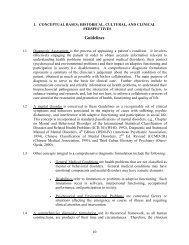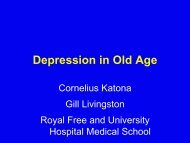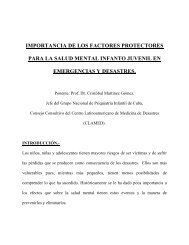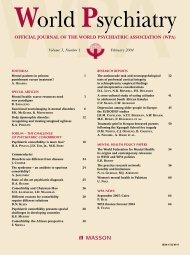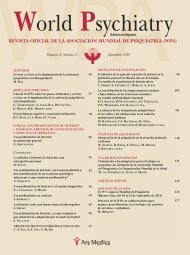ABSTRACTS - World Psychiatric Association
ABSTRACTS - World Psychiatric Association
ABSTRACTS - World Psychiatric Association
Create successful ePaper yourself
Turn your PDF publications into a flip-book with our unique Google optimized e-Paper software.
psychosocial interventions in randomized controlled trials. Such<br />
interventions include cognitive behavioral social skills training, functional<br />
adaptation skills training, diabetes awareness and rehabilitation<br />
training, work rehabilitation, and an intervention specifically<br />
focused on Latino patients. The results show that psychosocial interventions<br />
are efficacious, practical, and acceptable to older patients<br />
with schizophrenia being treated with medications. Shared decision<br />
making involving patients and caregivers is necessary for choosing<br />
specific treatments for specific patients.<br />
US25.<br />
PREVENTION AND EARLY INTERVENTION<br />
STRATEGIES IN COMMUNITY MENTAL HEALTH<br />
SETTINGS<br />
US25.1.<br />
PREVENTION AND EARLY INTERVENTION<br />
STRATEGIES FOR MENTAL DISORDERS:<br />
THE PREVENTION GAP<br />
S. Saxena<br />
Department of Mental Health and Substance Abuse,<br />
<strong>World</strong> Health Organization, Geneva, Switzerland<br />
Prevention of mental and behavioral disorders is likely to be the most<br />
effective strategy to reduce the growing burden of these disorders in<br />
the long term. While scientific knowledge in this area has increased<br />
substantially in the last decade, only a small fraction of it is being used<br />
in practice, leading to a large prevention gap. This paper focuses on<br />
two aspects of prevention: a) the practical applicability of knowledge<br />
on social and macro-economic factors in causation of mental disorders<br />
and b) feasible preventive interventions within primary and secondary<br />
health care in low and middle income countries. Reference is<br />
made to the recent publications of WHO Commission on Social<br />
Determinants of Health and other sources relevant to prevention of<br />
mental disorders at policy as well as health care levels. Attempts to<br />
evaluate the effectiveness and feasibility of prevention strategies within<br />
primary and secondary care and to integrate these within the WHO<br />
essential package for mental, neurological and substance use disorders<br />
are also described. Issues related to responsibilities for prevention<br />
and funding of prevention programmes are enumerated. Conclusions<br />
are drawn on the steps needed to narrow the prevention gap.<br />
US25.2.<br />
EARLY COMMUNITY INTERVENTION FOR YOUNG<br />
PEOPLE WITH EMERGING MENTAL DISORDERS<br />
P.D. McGorry<br />
ORYGEN Youth Health Research Centre, University<br />
of Melbourne, Australia<br />
Preventively-oriented clinical care is a realistic and achievable goal in<br />
developed countries and a potentially cost-effective strategy for lowand<br />
middle-income countries and developing economies. The frontier<br />
for mental health promotion, prevention and early intervention is<br />
located at the community level, where an enhanced primary care<br />
model can offer a low stigma gateway for multidisciplinary evidencebased<br />
interventions. This is particularly relevant for young people<br />
with emerging mental disorders where help-seeking and engagement<br />
are especially dependent on the setting and the culture of care. The<br />
headspace program developed with the support of the Australian government<br />
has created 30 new “communities of youth services” or “onestop<br />
shops” across the nation over the past 2 years and many thousands<br />
of young people are gaining better access to multidisciplinary<br />
mental health care as a result. Initial experiences and data are featured<br />
and broader lessons for preventive community care drawn.<br />
US25.3.<br />
PORTLAND IDENTIFICATION AND EARLY<br />
REFERRAL (PIER): CONVERSION AND INCIDENCE<br />
OUTCOMES IN A CATCHMENT-AREA-WIDE<br />
PSYCHOSIS PREVENTION PROGRAM, 1994-2008<br />
W.R. McFarlane, W. Cook, D. Downing, A. Maloney<br />
Maine Medical Center, Portland, Maine, USA<br />
Portland Identification and Early Referral (PIER) is a population-based<br />
system of early detection and treatment for the prodrome to psychosis<br />
in people aged 12-35. The goal is to reduce the incidence of psychotic<br />
disorders in Portland, Maine, USA (population 330,000). Treated cases<br />
receive comprehensive evidence-based treatment and rehabilitation.<br />
PIER has educated the community-at-large and trained over 5000<br />
health, education and youth-related professionals to identify young<br />
people at ultra-high-risk of psychosis. Eligibility for treatment is established<br />
by Structured Interview of Prodromal Syndromes (SIPS)/Scale<br />
of Prodromal Symptoms (SOPS) criteria. The treatment is a prodromespecific<br />
combination of psychoeducational multifamily group, supported<br />
education/employment, assertive community treatment and psychotropic<br />
medication. Over seven years, there were 966 referrals, of<br />
which 259 (37.0%) were assessed and 149 were admitted to study. Of<br />
those with currently available one-year outcomes (n=93), 9 (9.7%)<br />
experienced psychosis meeting SOPS criteria. The mean Global Assessment<br />
of Functioning (GAF) score was 38.1 at baseline and 54.5 at 12<br />
months (pre-post t (92)=8.02). First hospitalizations for a psychotic disorder<br />
were compared between experimental and control geographic<br />
areas and between control (1994-2000) and experimental (2001-2006)<br />
time periods. The net pre-post difference between control and experimental<br />
area was 29.7/100,000. The control area experienced a 2.4-fold<br />
increase in incident cases during the test period (2001-2006), in contrast<br />
to a stable rate in the experimental area. These data suggest that community-wide<br />
early detection and treatment is feasible and achieves low<br />
conversion rates. The relative difference in incidence between treatment<br />
and control catchment areas is consistent with a community-wide<br />
treatment effect, in the absence of confounding factors.<br />
US26.<br />
MANAGING COMORBIDITY OF MENTAL<br />
AND PHYSICAL ILLNESS<br />
US26.1.<br />
COMORBIDITY OF MENTAL AND PHYSICAL<br />
DISORDERS: A CENTRAL CHALLENGE<br />
FOR MEDICINE OF THE 21ST CENTURY<br />
N. Sartorius<br />
<strong>Association</strong> for the Improvement of Mental Health Programmes,<br />
Geneva, Switzerland<br />
The recognition and treatment of the simultaneous presence of mental<br />
and physical disorders has become a central challenge for health<br />
care systems worldwide. The comorbidity of mental and physical disorders<br />
is frequent and its consequences for the persons who have<br />
both types of disorders are numerous – ranging from a worsening of<br />
the prognosis of both disorders (and a more severe impairment and<br />
consequent disability) to the exposure to risks of inappropriate or<br />
insufficient treatment. The management of the comorbidity of mental<br />
27





